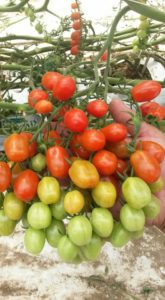
The Blush Tomato Glasshouse in Guyra
Nothing beats the taste, texture and sweet juiciness of a freshly picked tomato in the height of summer. We’re all well aware of the trends and benefits of eating seasonally, but by taking advantage of the technology used in hydroponic growing practices, we can enjoy high quality tomatoes throughout the entire year and avoid those that have been picked green, cold stored and manipulated to the tasteless varieties that sometimes find their way onto our plates in winter and spring.
There’s a reason why a blushing hydroponic tomato tastes better, is more appealing to the eye and are, admittedly, sometimes slightly more expensive than their field grown cousins and it all comes down to controlling their growing environment…
Glass and greenhouses are the perfect place to create the environment a crop needs to grow – and not just grow, but thrive, blossom, and develop into a taste sensation that transports your tender tastebuds to another world!
Here’s why, even though a hydroponic truss of delights might cost a dollar or two more per kilo, you should reach to the higher shelves in your fruit shop or supermarket and pick-up a truss of hydroponically cultivated tomatoes.
THE ART AND SCIENCE OF HYDROPONICS – well, in brief!
Most of the population has a fair idea of the concept behind hydroponics – the plants are grown indoors in an inert medium and are fed by nutrient-rich, pH balanced water while the grower manipulates the indoor environment to the ideal climate for optimal growth, yield and fruit production – it’s along the lines of heating your home through winter.
What makes hydroponics a more superior growing method (and we are not trying to eradicate field growing methods here, just stating some facts) is that the nutrient-rich water is recycled through the hydroponic channels, reducing water and essential element usage – most hydroponic growers use a third less water to grow twice the amount of produce than traditional farming methods.
Natural pest controls are generally introduced to the indoor environment, cutting out the use of hard-chemicals; controls like ‘Integrated Pest Management’. If a pest is discovered in the local area or greenhouse, farmers introduce a new insect, one that is the natural predator of the bad bug – I like to call it the ‘bug eat bug’ method. If the situation is identified early and given quick attention, no insecticides are sprayed on the crops.
THE HYDROPONIC FARMER
In the early days of hydroponic cultivation in Australia, hydroponic tomatoes received a pretty bad rap – tasteless, bland, pale and expensive – so many consumers (and growers for that matter) avoided hydroponic crops like the plague.
But as we approached the 21st-century knowledge of hydroponic practices evolved. Jump to the present day and hydroponic growers are not only conscious of environmental impact and sustainability, but also of the importance of flavour and nutritional value.
Growers have acknowledged that we have entered into a ‘fresh food revolution’ where consumers are avoiding cheap, mass-produced, poor quality produce. Savvy consumers are buying less produce in favour of food that has a higher nutritional value, is environmentally sound, in season and tastes like it should taste.
We no longer want fresh produce that has travelled thousands of miles to reach our plates, amassing more stamps on their passports than us. This is where hydroponics becomes our food saviour, we can grow more produce on less land than ever before, utilising even barren waste-land where nothing has ever grown in the past, and not only can we grow fresh and flavourful fruits out of season, but because hydroponic produce is grown closer to our population we are drastically reducing our carbon footprints and lowering food miles.
WHAT MAKES A HYDRO TOMATO BETTER?
Essential nutrients are supplied directly to the plants root system, constantly, so the plant can conserve its energy and concentrate on using that energy to grow its budding fruits.
Growers can cater to the specific growing requirements throughout a plants life cycle on a daily basis and give the plant the right nutrients at the right time, depending on where the plant is at in its growth cycle. A tomato requires different levels of nutrients when it’s in the fruit producing stage, for example.
Because of this, nutrient levels are tested daily so the growers knows exactly which nutrients the plant is receiving, it’s much harder to control nutrient levels in the ground.
Hydroponic tomatoes generally aren’t picked green and stored in a cool room because hydroponic growers understand that to produce superior fruit they must be ripened on the vine for ultimate flavour, sweetness, and juiciness and to develop a rich and invigorating colour.
Because they’re grown in a controlled environment there is less produce wasted from environmental or atmospheric influences. Take pest damage as an example; it’s rare to find a hydroponic crop ruined by pest infestation because it’s easier to monitor and control an indoor environment, and since there is less risk of crop damage, growers tend to outlay more money on quality seed stock – producing a more superior fruit. Plus they don’t have to worry about frost because they can heat the greenhouse and the water the plants uptake. And the roof keeps away any threat of hail damage too!
Then we come to production – the yield far out-weighs that of field-grown tomatoes with small to medium commercial growers looking to yield a minimum of around forty kilos per-square-foot and large growers looking to yield up to fifty-five to sixty kilos.
POLLINATION PRACTICES ADDING TO THE COST
At this stage in Australia the fruit has to be pollinated manually, unfortunately increasing man-power and hours, but hopefully one day in the future the Australian government will allow the importation of Bumble Bees to do the job for the growers.
LONGEVITY
According to Mark from Flavorite Hydroponics, hydroponic tomatoes can have a fresh and happy shelf life of up to two weeks once harvested if you store them correctly.
The optimal holding temperature for a tomato sits at 13C, making a refrigerator the worst possible home for them because the cold kills the cells in the fruit, in-turn reducing the flavour of the tomato. Store them the cupboard or in a fruit bowl on the bench.
GREEN PICKING
There are a couple reasons field growers pick tomatoes green – firstly, a ripe tomatoes worst enemy is over-handling, green tomatoes travel better and are less likely to bruise in transport or with constant handling.
The problem here is that the flavour and juiciness of the tomatoes hasn’t had enough time to fully develop and the end product will never be as sweet and delicious as fruit that’s picked closer to ripeness – those in the industry call this procedure ‘cold flick’. The fruit will continue to ripen naturally unless some crafty transport company or supermarket needs the shelf life extended, then they’ll cold-store them. At 4C the tomato will stop its natural ripening progress and lie dormant until the temperature is increased.
AROMA
Head down to your local supermarket or fruit shop and find yourself some field-grown tomatoes and a truss of hydroponic tomatoes – pick them up one at a time and breathe in their aroma – the scent of the hydroponic bunch will fill your senses and be far more aromatic than the field grown variety – that’s if you can even detect the scent of the field grown variety.
The reason behind this is that hydroponic tomatoes are ripened and left on their vine. It’s the vine that holds the aromas and essential oils that give off that particular scent we associate with a ripe, fresh tomato. The next time you come across a tomato plant rub the stem between your fingers, you’ll be blown away by the strength of the scent it leaves behind.
GROWERS TIP
Chris Burges has been growing hydroponic tomatoes for twenty years, so I dropped in to learn a couple of his tricks to producing the best hydroponic tomatoes in town.
If you’d like to give the wonderful world of hydroponic tomato growing a whirl, here are a few of his top tips. Don’t have a green thumb? No sweat, Australia produces some of the best hydroponic tomatoes in the world! Just keep an eye out for them at your local fruit shop, farmers market, or supermarket.
Here’s what Chris had to say…
Prune them right!
Tomatoes need to be pruned 2 ways;
Firstly – you have to prune the shoots – with every leaf there is a shoot
Secondly – you have to prune the flowers back to 5 if you are growing on the truss;
Take the first open flower off, then prune it back to 5 flowers, taking note of which flowers are open, because that is the order they will ripen in.
If you leave 8 or 9 tomatoes on the truss you will have two problems. The first tomato will go soft before the last one ripens and you will end up with a lot of medium sized tomatoes.
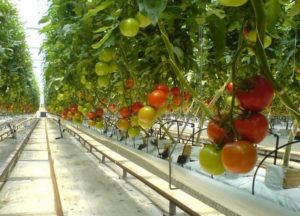
Inside the glasshouse
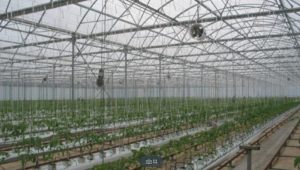
The tomato plants are tied to the roof of the glasshouse so our farmers can gently encourage the direction they grow in.
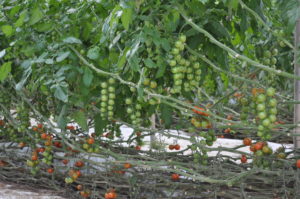
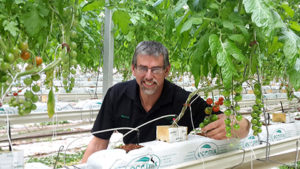
Marcus Brandsema inside his tomato glasshouse with his coco coir media. Coco coir is an inert (sterile) media perfect for hydroponics. It’s also environmentally friendly, so much coco fibre is recycled to make new products all over the world and coco coir for growing is an effective way to reduce waste after coconuts have been harvested.

